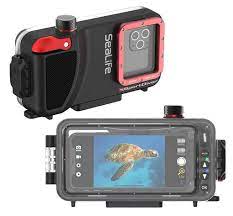Using your mobile phone while scuba diving: Is it a good idea?
****** Update Article on DIVE IN: have a look at the review: here ******
Underwater housings for your phone: The comparative.
The cameras on our mobile phones are becoming more and more powerful. They go everywhere with us and although the quality is not as good as on a dedicated camera and as the saying goes “the best camera is the one you have on you”.
Travelling without having to carry heavy and bulky equipment is quite promising. In addition, it will significantly limit the high costs of purchasing a camera, lenses, housings, and lights needed to take underwater pictures.
Let’s now look at the best practices to follow to return from a dive with your mobile phone in perfect working condition.
Avoid waterproof pouches
You will find them in every seaside shop; these waterproof pouches are made for all phone models and not for scuba diving.
They are fine for snorkelling, but they can’t withstand the pressure at greater depths. Beyond a few meters deep, the touchscreen can easily be blocked because of the surrounding pressure and no longer respond to your commands, or worse, the pouch can leak and drown your faithful companion.
Opt for complex plastic cases instead.
Just like the housing of a traditional camera, there are housings explicitly made for mobile phones. Adapters can be supplied with the housing for a better fitting, but check with your retailer to see which models the manufacturer supports.
These housings consist mainly of three parts: a gel screen to control the phone’s touchscreen, a hard shell to protect against pressure, and a glass panel just before the lenses, to take photos and videos and limit depth-related problems.
There are also pressure balancing systems built into the housing handle to make it safer and able to go deeper, but these will be more expensive than the basic models.
Regardless of the housing and to limit the risks, it is important not to play with the limits. For example, it is best to avoid going to 29.9m if the housing’s limit is 30m. It is better to keep a safety margin and keep this good habit in all areas of diving.
Take your housing underwater.
Before dropping into the ocean, the housing should be tested and checked for leaks. This should be done at the beginning of each dive, or your phone will drown, and you will not be able to do anything to save it.
At the beginning of the dive, check that the housing remains watertight around 3-4m and that no bubbles are escaping from the housing. Test that everything is working correctly and if there are any buttons, that they all work without leaking.
Little tip: Remember to put silica gel bags in the housing to prevent the glass from fogging and keep your photos sharp.
NEW SUPER HIGH TEC PRODUCT:
For a few years, we can see on the market some fantastic projects from crowdfunding platforms with millions of dollars in interest. The last and most famous is Divedroid a high-hand product from Samsung and iPhone. We were not able to test it, and we do have our concerns concerning the price Vs utility. A mobile phone will never have the quality of the camera or Micro third, and now we are nearly riching the 1000$ cost. At this price, We strongly advise focusing on a TG5/6 or something made for the underwater photo 🙂
Taking it a step further
You can already start taking photos and videos with your phone in the housing. Still, if you want to take it to the next level, then you’ll need to invest in some almost essential accessories for underwater photography.
The main thing that will change your photos is a strobe or a video light to illuminate your scenes. You can mount it on a tray for better control.
If you don’t have lights, don’t hesitate to invest in a red or magenta filter depending on the colour of the water you are diving in. They will give back colour to your photos and improve them.
There are also wet lenses, macro or wide-angle, which allow you to make more specialized images, which give a different perspective.
Finally, it is advisable to protect your housing to avoid scratches, especially on the glass.
Once your passion for underwater photography has developed, you can invest in higher-end equipment confidently.
Please contact us if you would like more advice and we will be happy to take you on a tour of the Komodo National Park.
At Dragon Dive Komodo, our photographers can help you improve your underwater photography, and you will bring back unforgettable memories.





